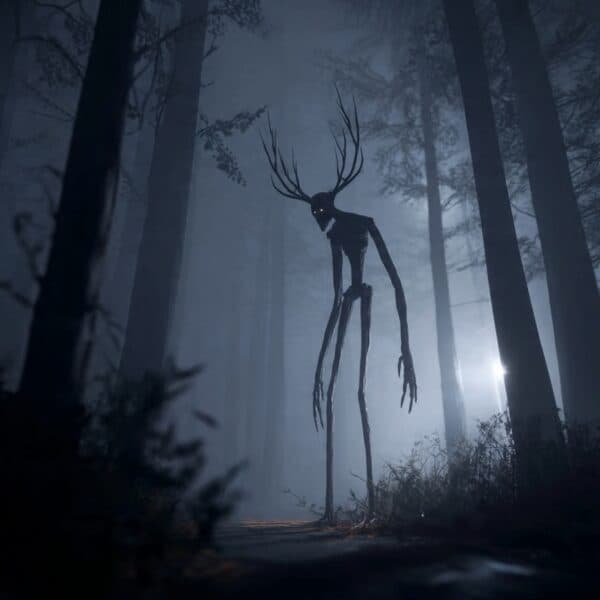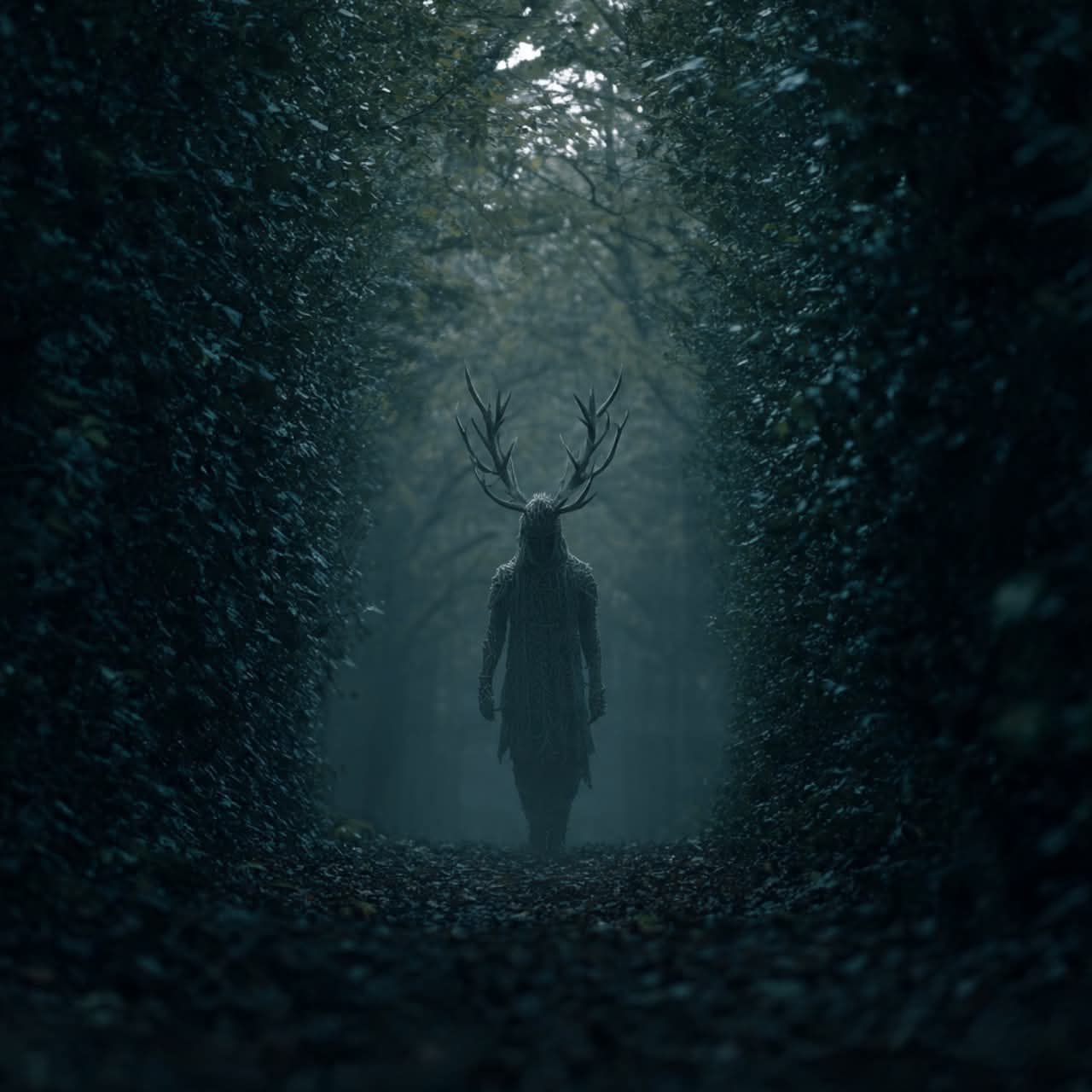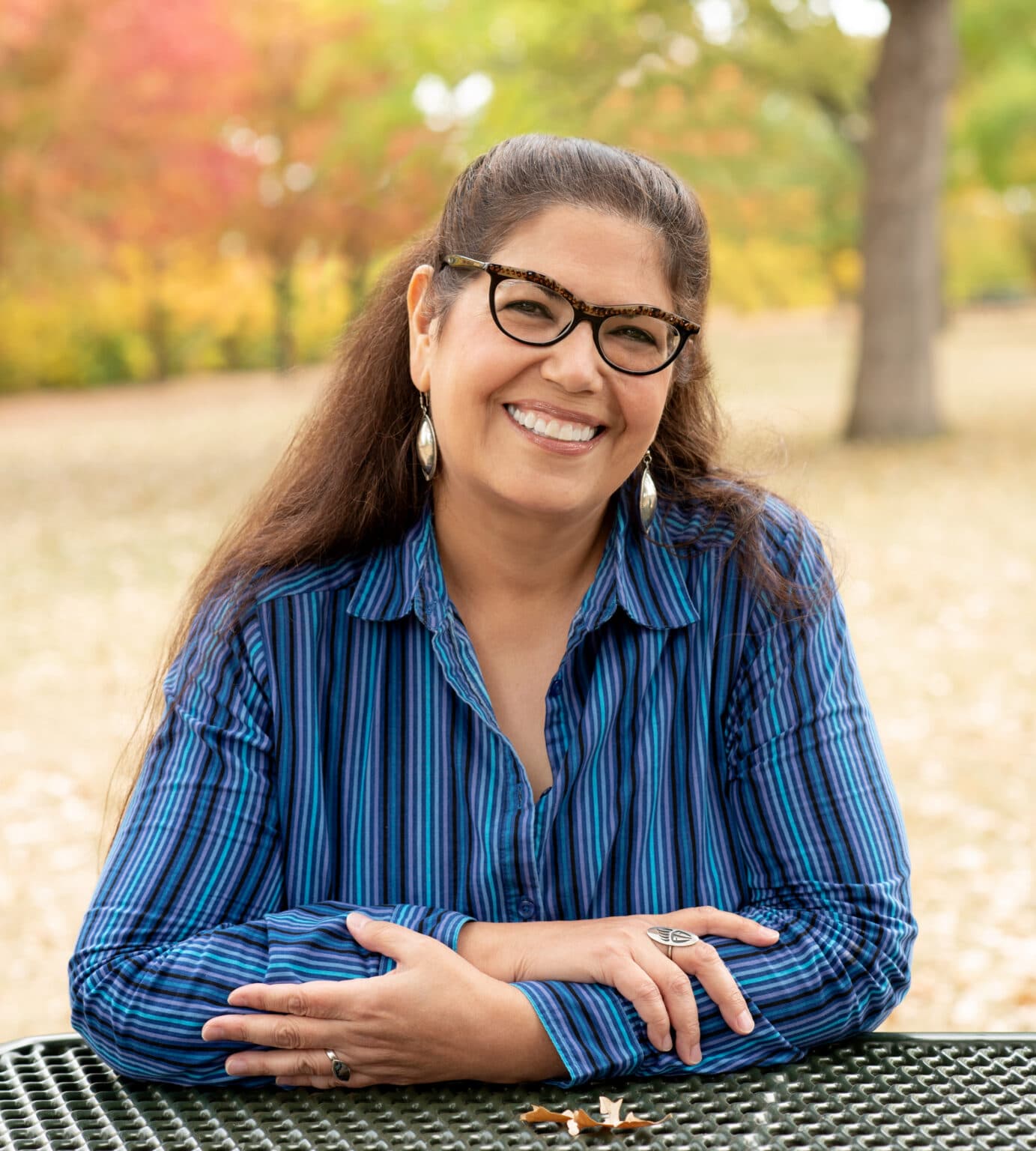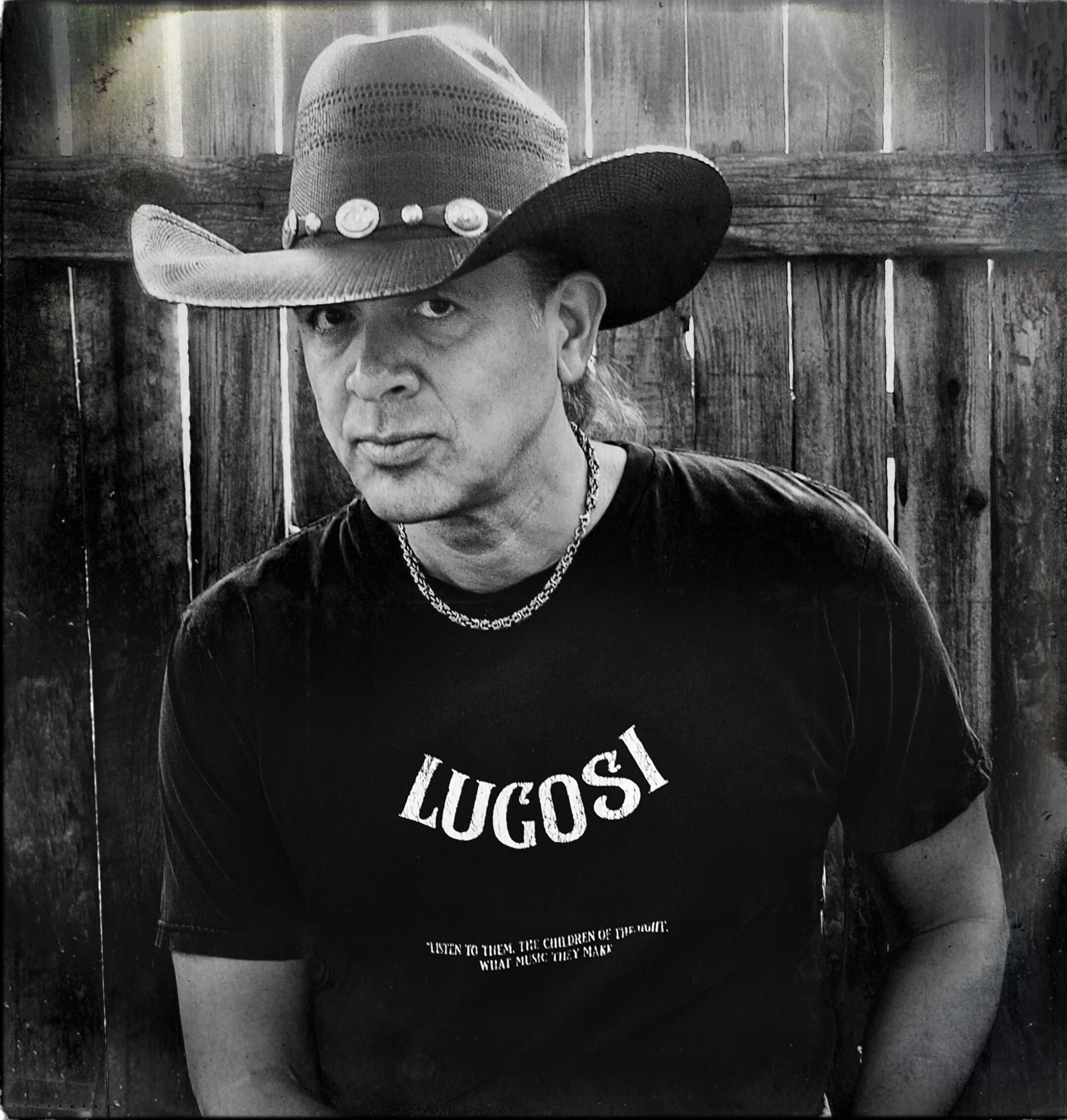Through self-determination and support, Native actress rebounds from ICE confrontation
Little people, ghost cars, vengeful spirits: the Indigenous supernatural crosses past and present
A look at the unique elements of Native horror

Many depictions of creatures in Native horror, including this Wendigo, are a blend of human and animal features. (Meta AI generated image)
One night as I began researching this article, a distinct sound came from outside my window: a monotone and brief whistle off in the woods.
With my mind already primed for otherworldly — and potentially sinister — things, I tensed up in my chair and waited.
A few seconds later, the whistle repeated.
And again.
Once more, but closer.
My Westernized brain told me it was likely some type of bird. Or maybe a child playing with a toy flute or similar gizmo. Except that this was well past midnight, and what kid would be wandering outside my window in our forested butte at such a time?
Then my Indigenous brain clicked in, recalling many an elder’s advice: Don’t whistle at night. And if something whistles at night, don’t respond.
Western brain would surely roll its eyes at what I did next, but I make no apologies: I slowly approached my window, gingerly cranked it shut and lowered the blinds. If there was any more whistling, at least I’d managed to mute it. I could return to my work in relative peace (though I briefly fixated on home invasion by some faceless changeling).
On never whistling at night, I’ll wager many fellow Natives have heard similar advice from their community or even heard tales of what happens if you respond or follow the night whistler.
Scarred at an early age
Horror author and Blackfeet citizen Stephen Graham Jones remembers his first scare. As a boy, his family shared a house with many other relatives.
“One of my uncles told me that when the house was being built, the construction worker lost his arm, and then he died,” Jones told Buffalo’s Fire. “And if I went out of my room I might see this construction worker looking for his lost arm.
That terrified me, and I stayed in my room.”
Years later, Jones realized that’s exactly what his uncle wanted.
“So I wouldn’t, you know, chance upon him and his girlfriend or anything,” he said with a chuckle.
But Jones still developed a taste for horror, becoming enthralled with werewolves through films like 1981’s “The Howling” and Whitley Strieber’s 1978 novel, “The Wolfen.” He said to this day, humanoid forms with animal heads still shake him to the core.
Jones has written many acclaimed horror novels, including “The Only Good Indians” and “I Was a Teenage Slasher,” where he not only gets to indulge his thirst for terrifying creatures and murderers, but also tackle old tropes that plague Native people, even in the fantastic world of horror.
“Native horror has less of what I call ‘coin-drop characters,’” Jones said. He says these devices appear whenever non-Native people in a story encounter something terrible and must learn its backstory.
“So they go out to wherever the local Indian dude lives, they ask him some questions, and he tells them a story and they leave. And that was his whole part in the story, which is to deliver an exposition,” explained Jones. “I call them coin-drop characters, because it’s like they walk up to him and put a quarter in his mouth and he repeats something.”
Which also happens to be the only thing the character does. Jones said these characters lack an arc and substance.
Your fascination with the supernatural is my tradition
Mona Susan Power is a citizen of the Standing Rock Sioux Tribe who has published novels and short stories, including “Dead Owls,” which was featured in the 2023 Native horror anthology “Never Whistle At Night.” The story weaves in figures from North Dakota history, including an interned Japanese-American who expresses a romantic interest in a Native woman (the narrator’s auntie) and Elizabeth “Libby” Bacon Custer, wife of the doomed General George Armstrong Custer. Unrequited love, tragedy and the intervention of spirits in dreams creates a surreal story in 1970s Bismarck.
Power says her mother could see spirits, and over time, she has been able to see them as well. But she doesn’t like how this ability and other aspects of her heritage gets branded from those outside her culture.
“I wouldn’t even call it supernatural, because for me it would just be part of life, just part of the experience,” said Power. “I think it’s because I’m pushing against that Western model of what is true and what is real versus what isn’t real.”
Power says this labeling is also applied to her writing.
“My work is always described as magical realism, and I say, ‘No, I’m writing my reality. I’m not trying to impose mine on others and you have to believe as I do.’ I’m saying allow space for others to have a different reality and a different belief system.”
Power is currently working on a novel about five Native students at Harvard who end up spending time at the infamous Lizzie Borden House (which serves as a museum and bed and breakfast). There they must not only deal with “angry settlers” but also with their past individual traumas.
Borden was acquitted of the brutal 1892 murders of her 69-year-old father and 64-year-old stepmother. She claimed to have found their bodies in the house and police were quick to suspect “foreigners.”
While Power was researching the house’s history, “I slept in the bedroom where the stepmother had been murdered,” she said. “And I knew I’d done so much research that I knew Lizzie Borden had done this. No question she was the killer.”
Power said she still had questions, and talked to the stepmother’s spirit as she went to bed.
“I didn’t have a scary experience there at all,” recalled Power. “I just felt this sadness come over me, and it’s like I was seeing a movie in my head of exactly Lizzie’s movements, exactly how she was able to pull this off and how she was able to get away with things.”
Power said she thanked the stepmother and had a good night’s sleep.
The Big Perils of Little People
One of the big sensations that came to Hulu this year was the true crime documentary “Blood and Myth.” At first glance, it resembles any number of similar gritty productions touching on murder and the pursuit of justice: Iñupiaq citizen and actor Teddy Kyle Smith is found at home with the body of his deceased mother and then flees for the remote Alaskan wilderness. He soon encounters and shoots two hunters. A coordinated manhunt succeeds in capturing Smith before he escapes further into the deep and treacherous terrain.
Iñupiaq citizen James Dommek Jr. is one of the executive producers. He said the story became even more intriguing when he heard of Smith’s statement to law enforcement after being captured.
“First thing he said to the troopers was, ‘They’re real.’ He just started talking about it, his experience out there,” said Dommek. “There’s an element here of something very different. I ended up just falling down the proverbial rabbit hole and chasing the story.”
Through interviews, research and an exploration of their mutual Iñupiaq culture, Dommek learns that Smith reported encounters with the “Little People” of the region, sinister beings called Iñukuns. At one point in the documentary, a series of unusual formations are found by surveyors way outside populated areas that Dommek believed are winter homes for the diminutive creatures.
“My jaw was on the floor,” Dommek told Buffalo’s Fire. “Just by the language of what the Bureau of Land Management was saying. These are government employees, archeologists, stating that they found possibly Little People homes in this very remote spot, and it is not accessible to people. It is very far.”
The modern judicial system didn’t completely buy Smith’s testimony, namely the part where he said he’d been convinced by the Iñukuns to commit his violent deeds and flee into the wilderness. While circumstances of his mother’s death were initially deemed suspicious, he was never charged or tried. But Smith was sentenced in 2014 to 99 years in prison for assault, robbery and attempted murder of the two hunters (to this day, Smith says he had no part in his mother’s death.) But for many Alaskan Native people, this is a cautionary tale that echoes stories passed down through the generations.
“We live in the darkness, like pitch black, dark,” said Dommek. “You know when you slip into the polar night and you’re at a certain latitude on the globe you’re not going to see the sun for about two-and-a-half months. And so the stories tend to kind of match that energy, a place of very extreme light and very extreme dark.
“And a lot of the stories that are in a lot of the traditionally Iñupiaq stories, are very frightening. Very, very, very much horror.”
At the same time, Dommek said what often looks like a horror story often has a deeper meaning. As a boy, he was terrified by the legend of the Big Mouth Baby, in which a young woman has a baby and doesn’t follow cultural rules. “She doesn’t do certain things with this baby and doesn’t follow things that we have adhered to for thousands of years,” Dommek said “She decides to do things her own way.”
This neglect of tradition causes the baby’s mouth to expand, and the newborn goes on a murderous rampage. It eats the mother, the family and any villager and dog it can chase down.
Ultimately a young orphan boy retrieves a jade knife from the village chief and chases the killer baby back. He kicks down a bridge as the baby attempts to escape. The murderous infant falls into the water, turning into a big hairy monster that lives at the bottom of the lagoon.
“The older I got, the more I realized that this story was about,” said Dommek. “If you don’t follow your cultural traditions, your culture will eat itself from the inside. If you don’t read and nurture your culture as if it’s a baby and follow the traditions of the elders, it will eat itself from the inside out and turn into a monster.”
The horror is still here
Everyone interviewed for this article acknowledged that while many Native horror stories feature fantastical elements, many are also rooted in historical atrocities that terrified their people in the past and continue to do so today. Yes, stories of a ravenous baby-monster that eats villagers or Little People who sway people to murderous acts are frightening in their own way, but they still pale to centuries of slavery, warfare, displacement, disease and institutional oppression including boarding schools.
Dommek says he sees this playing out in how commercial development and energy exploration threatens natural resources and the environment. He says capitalism has caused a dangerous disconnect with the earth: “The land became something to own and to terraform and to manipulate for our will. The Western mindset is, ‘I own this land,’ and the Indigenous mindset is, ‘I belong to this land.’”
For Power, raising Native voices in literature — including horror — means reminding readers of past tragedies that still haunt tribal communities to this day. With the 150th anniversary of the Battle of Little Bighorn coming up next June, commemorations of what Natives refer to as the Battle of the Greasy Grass will revitalize one-sided accounts popularized in early Hollywood Westerns and dime-store novels.
Power said speaking her truth about what some call “Custer’s Last Stand” is something she’s done since grade school.
“I would always eventually raise my hand and say, ‘I was raised understanding this,’” just so I would put it out there and that there’s another version,” she said. “I grew up sort of haunted in a way by that story, and the injustice I felt that was what was done to us back then, but continues to be done to us when our histories, our side, isn’t listened to or taken seriously.”
And for Jones, Native horror is distinct for its own set of anxieties and resentments as events like anti-DEI initiatives, immigration crackdowns and political uncertainty dominate headlines.
“Like we’re very aware of all the stereotypes circulating in the world, so sometimes there’s pushback and internalizing that stuff in ways you wouldn’t find in a non-Native horror story,” he said. “What distinguishes Native horror is we do have a sense of ‘Let’s wait this out.’ We’ve been doing that since 1492, and we’re doing that now. We’re watching America crumble around us.”
The Brighter Note
If history has taught us anything, it’s that besides being resilient, Native people are also able to laugh and joke even during the most difficult times. Humor can be part of even the creepiest of legends too. I remember hearing tales of an old beater rez-mobile that glowed in the dark and followed hapless drivers in the back roads of the Dakotas at night. If someone was foolhardy enough to stop, get out and look inside the phantom car, they’d be stared at by a pack of leering ghouls.
Inevitably someone would follow that up with something like, “Yeah, but they still had to get that car back to their cousins before the work week, right?”
At Buffalo’s Fire, we’ve gathered our staff on video to share advice from their elders, the legends that haunted their childhoods and the spine-tingling moments they encountered the otherworldly. Take a look — if you dare.
Brian Bull (Nez Perce Tribe)
Senior Reporter
© Buffalo's Fire. All rights reserved.
This article is not included in our Story Share & Care selection.The content may only be reproduced with permission from the Indigenous Media Freedom Alliance. Please see our content sharing guidelines.
Elaine Miles remembers her friend’s sage advice on being a Hollywood professional
The film tells the story of white buffalo calves on the Turtle Mountain Reservation
Teachers are incorporating Native perspectives into the holiday
We put the question to Native community members
Indigenous designers showcased at Far North Fashion Show










